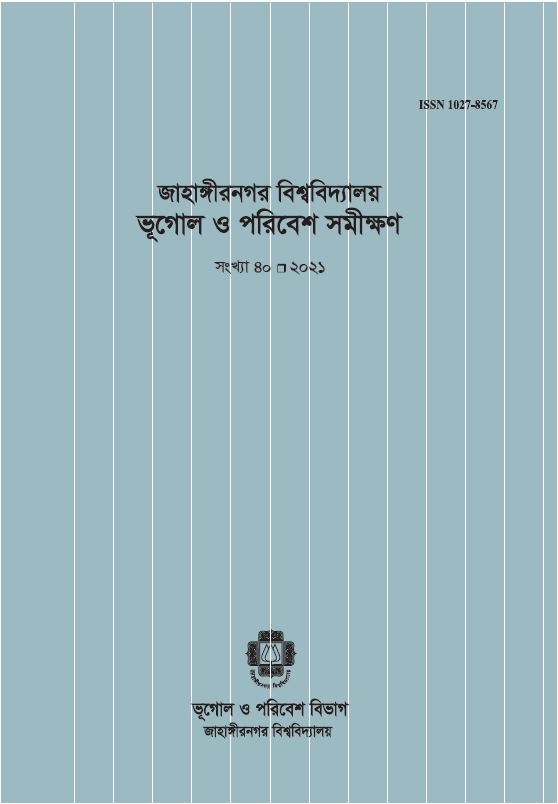গোপালগঞ্জ জেলায় ভূমি ব্যবহার ও ভূমি আবরণ (LULC) পরিবর্তনের পর্যবেক্ষণ ও বিশ্লেষণ
Main Article Content
Abstract
সারসংক্ষেপ: গোপালগঞ্জ বাংলাদেশের অন্যতম দ্রুত সম্প্রসারিত অঞ্চলগুলির মধ্যে একটি যা ঢাকা বিভাগের অধীনে অবস্থিত। যেকোন নগর পরিকল্পনা ও ভূমি ব্যবস্থাপনার জন্য ভূমি ব্যবহার এবং ভূমি আবরণ পরিবর্তনের পর্যবেক্ষণ অপরিহার্য। অতএব, এই গবেষণাপত্রটির মূল লক্ষ্য হচ্ছে GIS এবং রিমোট সেন্সিং টেকনিক ব্যবহার করে গোপালগঞ্জ জেলার বিশেষ করে গোপালগঞ্জ সদর ও টুঙ্গিপাড়ায় ভূমি ব্যবহারের ভূমি আবরণ পরিবর্তনের উপর ২০১৪ থেকে ২০২১ পর্যন্ত পর্যবেক্ষণ ও বিশ্লেষণ করা। Landsat 8 OLI/TIR সেন্সর থেকে ৩০মিঃ রেজোলিউশন সহ এবং শূন্যের কাছাকাছি ক্লাউড কভার যুক্ত ২০১৪, ২০১৬, ২০১৮ এবং ২০২১ সালের স্যাটেলাইট ছবিগুলি নেওয়া হয়েছে। Supervised Maximum Likelihood এবং NDVI সূচক পরিবর্তনগুলি সনাক্ত করতে এই গবেষণায় ব্যবহার করা হয়েছে। তদুপরি,পরিবর্তনগুলি মূল্যায়ন করতে এই গবেষণায় ছয়টি শ্রেণি ব্যবহার করা হয়েছে যার মধ্যে রয়েছে গাছপালা, কৃষি, খালি মাটি, কালো মাটি, জলাশয় এবং বিল্ড—আপ এলাকা যেখানে সামগ্রিক নির্ভুলতা ছিল ৮৩% থেকে ৯৬% পর্যন্ত। এই সমীক্ষাটি প্রকাশ করে যে নগরায়নের কারণে বিল্ড আপ এলাকাগুলি ক্রমবর্ধমান কৃষি জমি, গাছপালা এবং খালি জমির বিপরীতে উদ্বেগজনক হারে বাড়ছে। এছাড়া, ২০১৬ সালে জলাশয় ৫.০৫% থেকে ৭.০১% পর্যন্ত বৃদ্ধি পায়, তারপর থেকে এতটা পরিবর্তিত হয়নি। অধিকন্তু, ২০১৮ সাল পর্যন্ত গাছপালা এলাকা বৃদ্ধির সাথে সাথে হ্রাস পায় (৪.২৭%) কিন্তু ২০২১ সালে করোনা মহামারী এবং লকডাউনের কারণে এই শতাংশ ৬.৬২% বৃদ্ধি পায়।
Abstract: Gopalganj is one of the fastest expanding regions in Bangladesh, which is located under Dhaka Division. Monitoring land use and land cover changes are essential for any urban planning and land management. Therefore, this paper attempts to monitor and analysis on land use land cover changes in Gopalganj District, more specifically in Gopalganj Sadar & Tungipara, from 2014 to 2021 using GIS & Remote Sensing Technique. Satellite images of 2014, 2016, 2018, and 2021 were taken from the Landsat 8 OLI/TIR sensor with 30m resolution, and the cloud cover was close to zero. Supervised Maximum Likelihood classification and NDVI indices were used in this study to detect changes. Moreover, six classes, including Vegetation, Agriculture, Bare Soil, Black Soil, Waterbody, and Build Up Area used in this study to evaluate the changes where overall accuracy was ranged from 83% to 96%. This study reveals that due to urbanization, build-up areas are increasing at an alarming rate in contrast to decreasing agricultural land, vegetation, and bare land. Besides, waterbody increases during 2016 from 5.05 % to 7.01%, and the aftermath not so much has changed since then. Moreover, vegetation area decreased with increasing time till 2018 (4.27%), but during 2021 this percentage increased by 6.62% because of Corona Pandemic and lockdown.

